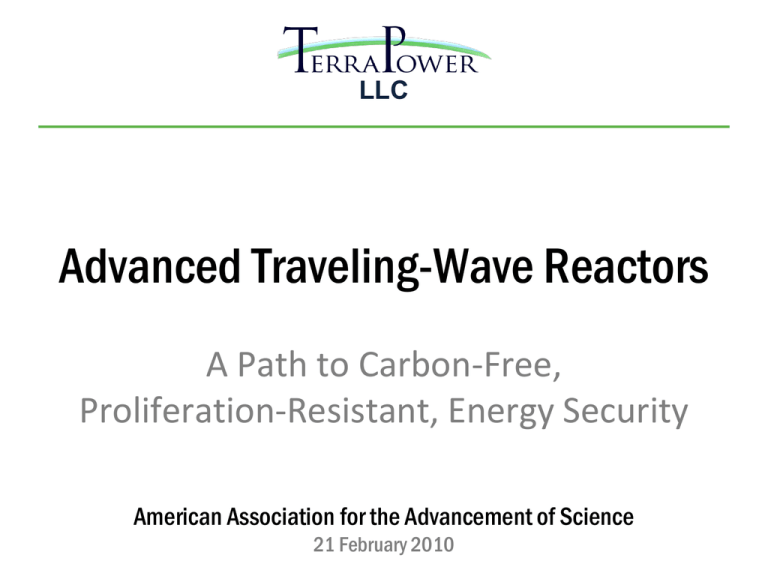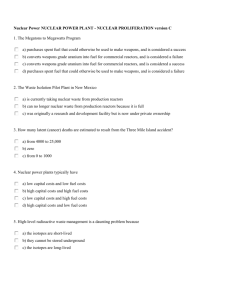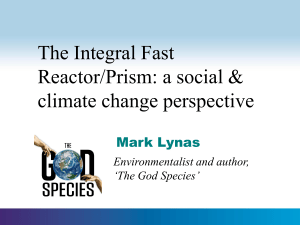Nuclear Initiative Overview
advertisement

LLC Advanced Traveling-Wave Reactors A Path to Carbon-Free, Proliferation-Resistant, Energy Security American Association for the Advancement of Science 21 February 2010 Renewables are Great, But They Face Interesting Challenges • • • • Low capacity factors for wind and solar Need for spinning reserve increases cost, complexity Little prospect for large increases to hydropower Large increases to biomass-fueled electricity will compete for cropland with biofuels, human food, and animal feed Source: EIA 2009 Annual Outlook 2 Capacity Factors 100% 80% 60% 40% 20% 0% Goal: 25% Electricity from Renewables by 2025 2008 Renewable sources 394 TWh (9.5%) Biomass: 60 Solar: 2 Geothermal: 17 Wind: 53 Hydro: 262 Required growth in nameplate capacity: 2025 Renewable sources Electricity generation from renewables: 1,219 TWh (25%) 9,462% 616% 410% Geothermal: 122 Wind: 366 Hydro: 300 Sources: EIA 2009 Annual Outlook, TerraPower 3 Solar: 195 285% Biomass: 232 Major Grid and Siting Challenges 2025 Renewable sources Biomass: 232 Solar: 195 Electricity generation from renewables: 1,219 TWh (25%) Geothermal: 122 Wind: 366 Hydro: 300 18,586 km2 new solar farms 10,085 km2 new wind farms Sources: NREL EIA 2009 wind, Annual solar Outlook, area calculators TerraPower 4 Major Grid and Siting Challenges 18,586 km2 new solar farms 10,085 km2 new wind farms OHIO MINNESOTA 5 Nuclear Faces Challenges As Well Nuclear Infrastructure Today is Complex and Expensive Uranium mining and milling Conversion to uranium hexafluoride Long-term geologic repository Actinide fuel fabrication Uranium enrichment Fuel fabrication Depleted uranium storage Reprocessing Spent fuel storage Nuclear power generation Use Unenriched Uranium as Fuel Many Steps Then Become Unnecessary Uranium mining and milling Conversion to uranium hexafluoride Long-term geologic repository Actinide fuel fabrication Uranium enrichment Fuel fabrication Depleted uranium storage Reprocessing Spent fuel storage Nuclear power generation A Simpler, More Secure and Economical Nuclear Energy System Depleted uranium storage Fuel fabrication Long-term geologic repository (with greatly reduced waste volumes) Nuclear power generation (with half-century refueling) Spent fuel storage (with greatly reduced waste volumes) Each 14-ton canister of depleted uranium can generate 60 million megawatt-hours of electricity… …enough to power six million households at current U.S. rates of consumption for a year. The existing U.S. stockpile of 700,000 metric tons represents a national energy reserve that could last for many centuries. TWRs can convert these 38,000 cylinders of “waste” to about $100 trillion worth of electricity. The TerraPower Team Distinguished and Growing (former affiliation) Physics Modeling Chuck Whitmer (Microsoft) Ehud Greenspan, UC Berkeley Pavel Hejzlar (MIT) Rod Hyde (LLNL) *John Nuckolls, Director Emeritus of LLNL Robert Petroski, MIT Nick Touran, (UM) *Thomas Weaver, LLNL *Lowell Wood (LLNL) *George Zimmerman, LLNL Engineering and Design Charles Ahlfeld (Savannah River Site) Tom Burke (FFTF) Bill Bowen, CBCG (FFTF) Tyler Ellis (MIT) Mike Grygiel, CBCG (FFTF) David Lucoff (FFTF, Texas A&M, INEEL) Jon McWhirter, (U.S.N., UT) Ash Odedra (ITER) William Stokes, President of CBCG Alan Waltar (TAMU, FFTF, PNNL) Josh Walter (Purdue) James Waldo, CBCG (EBR-II, FFTF) and 20+ other collaborators * Winners of DOE’s E.O. Lawrence Award 11 Materials/Fuels Development Kevan Weaver (INL) Ken Czerwinski, UNLV Sean McDeavitt, TAMU Ron Klueh (ORNL) Ning Li (LANL) Jacopo Buongiorno, MIT and other collaborators The TerraPower Team Business and Technology • Bill Gates • Nathan Myhrvold • • • Founder and CEO of Intellectual Ventures, former CTO of Microsoft John Gilleland Formerly VP at Bechtel, Director of ITER, and Sr. VP at General Atomics David McAlees Former co-chair of Siemens Nuclear Division Roger Reynolds Former CTO of Framatome ANP/AREVA 12 The First TerraPower Reactors • • • • • • Fueled mainly by depleted uranium, a byproduct of uranium enrichment Small amount of enriched uranium is used to start the reaction Just one fuel load lasts for decades No reprocessing Reactor is sealed and below grade Near zero proliferation risk 13 Advanced Traveling-Wave Reactors Making Fuel and Burning It in One Pass, in One Place 14 The Traveling-Wave Reactor (TWR) • Waves make, and then burn, fissionable material as they travel across the core. • Waves are launched with a kernel of enriched uranium, but sustained solely by fuel made from depleted uranium or natural uranium • Operates with well-developed technologies 15 Familiar Breeder Reactor Physics, With a Twist 16 Prismatic Core Wave Moves Through the Fuel Fission begins Burning wave Breeding wave At steady state, the power density is similar to that in a conventional fast-neutron reactor Cylindrical Standing-Wave Reactor • • Fuel is moved to the wave, instead of the wave moving through the fuel After startup, the power density is typical of a conventional fast reactor 26 TWRs can also run on Spent Fuel from Light Water Reactors • • • • • Existing nuclear plants in the U.S. are now storing about 60,000 metric tons of “spent” fuel Enough fuel to power 100 TWRs—each generating 1.2 GWe—for a century No separation of uranium or plutonium required China plans to have ~100 GWe of nuclear power by 2020 These new reactors will expel similar amounts of “spent” fuel by mid-century 27 TWRs Large and Small Different designs for different markets: • • Small, modular reactors for factory production, flexible for applications and markets Gigawatt-scale TWR that fits well within existing plant designs eWM fo sderdnuH RWT raludoM 100s of MWe Modular TWR 28 eWM 82 11 1,150 MW e RWT CTWR One-Gigawatt TWR • • • • High temperature, so high efficiency • 1.2 Gwe net from 3 GWt No spent fuel pool Physics forces a shutdown if the temperature gets too high Most components will be familiar to the NRC 29 Next Step: Build a Demo Reactor • • • Traveling waves are feasible and stable • Confirmed by high-fidelity computer simulations of the nuclear physics Nearly all pieces of the candidate design have been validated by previous fast reactors • EBR-II, Phénix, JOYO, FFTF, BN series and others But we need a full-core demonstration • Demo will verify traveling-wave behavior and demonstrate fuel limits 30 The First TWR: TP-1 • • • • • • • • To begin operations in 2020, producing electricity for the grid 350–500 MWe capacity (900–1,250 MWt) No refueling needed for 40 years Mainly fueled with depleted uranium, with U235 as starter fuel Designed to accommodate advances in fuels or materials Also could be operated as a “standard” fast reactor TP-1 core may be compatible with existing or planned sodium-cooled fast reactors International cooperation will be needed to construct and operate TP-1 31 TerraPower Reactors Approach The Ideal • Sustainable • Sustainable • Minimizes its environmental Phases out mining Burns existing and future DU footprint • Burns waste • Meets global energy needs indefinitely and other waste as fuel Known fuel supplies are sufficient for many centuries • Safe • Safe • Meets the highest safety Uses latest safety features • Affordable standards • Affordable Needs no reprocessing, and • Competes with—or beats— eventually no enrichment existing nuclear systems 32 The design provides “ the simplest possible fuel cycle,” says Charles W. Forsberg, executive director of the Nuclear Fuel Cycle Project at MIT, “the and it requires only one uranium enrichment plant per planet.” TECHNOLOGY REVIEW, MARCH/APRIL 2009 33 For More Details • • • • • • • “Novel Reactor Designs to Burn Non-Fissile Fuels,” International Congress on Advances in Nuclear Power Plants 2008 (ICAPP ‘08), paper 8319 “A First Generation Traveling Wave Reactor,” ANS Transactions 2008, Vol. 98, p. 738 “High Burn-Up Fuels for Fast Reactors: Past Experience and Novel Applications,” International Congress on Advances in Nuclear Power Plants 2009 (ICAPP ‘09), paper 9178 “A Once-Through Fuel Cycle for Fast Reactors,” 17th International Conference on Nuclear Engineering (ICONE-17), paper ICONE17-75381 “Extending the Nuclear Fuel Cycle with Traveling-Wave Reactors,” GLOBAL 2009, paper 9294 Article in press at the Journal of Engineering for Gas Turbines and Power http://intellectualventureslab.com and TerraPowerInfo@intven.com 34






